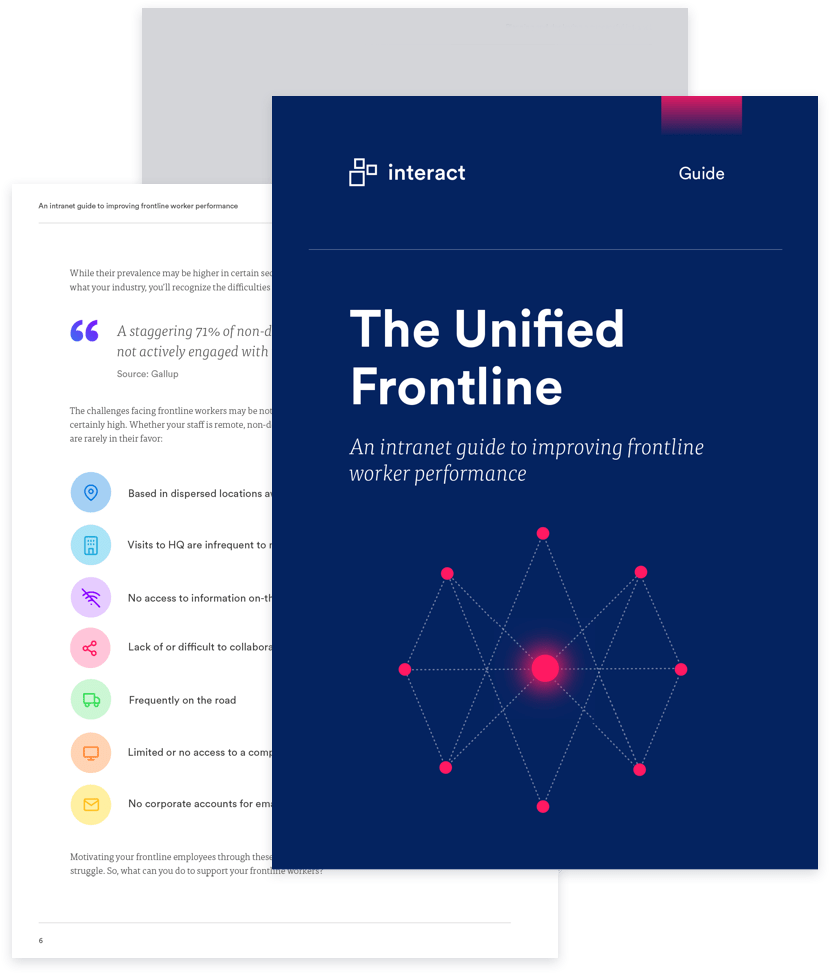5 irrefutable reasons why your retail frontline is unengaged

They may be the face of your brand, but how engaged with your organization are your frontline workers?
Your shop floor employees are the face and soul of your organization. Frontline workers are the first point of contact between your business and your customers. The ones who spend their time managing operations, sharing products, and creating your customer experience. Yet even though these employees essentially shape the opinion of your organization’s brand, they remain an afterthought in many digital and internal communications efforts.
So, why are retail front line workers so overlooked – and why is this a massive risk to a business?
Traditionally, frontline employees are the group that organizations struggle to engage and retain most. The fact that retails workers are ranked among the lowest in terms of total motivation highlights the many limitations and challenges they face as employees. For many reasons, organizations are not meeting frontline employee needs which ultimately leads to an increased turnover rate and decreased performance.
The task now plaguing organizations is not only how to retain your frontline workers, but how to improve performance among the individuals in charge of driving your customer experience.
Investing in your frontline has a profound effect on your organization as a whole, and a retail intranet can meet the many challenges that stand in the way of a fully engaged, happy workforce.
1. Disconnection to the organization

When it comes to your frontline staff, the biggest culprit to their lack of engagement and productivity is loneliness. Why is this?
Many retail frontline workers will admit that they experience a lack of support from management and C-suite executives. This isn’t helped by the physical distance that exists between these two groups.
No one likes to be kept in the dark. Mistrust, disengagement, and feelings of unappreciation are all symptoms of a broken communication method. A huge complaint among frontline staff is that senior leaders make changes to the organizational structure or processes without informing them.
How can an intranet help?
As the window to any digital workplace, an intranet has the power to instill a connection between your employees and your business. Here, leaders can easily communicate company values, share news and updates, celebrate organizational successes and inform everyone, regardless of location, of new developments or objectives. Employers should not be scared to increase social activity. There are a number of intranet features that make communicating with your frontline easy.
Blogs
Blogging, for instance, enables staff to connect in an informal environment. Here staff members can feel comfortable sharing stories, ideas, and feedback in an informal setting.
News
Using an intranet to publish company updates, share strategic plans, introduce new staff members and communicate or manage change can provide even the most dispersed of staff with an understanding of what’s happening in their organization, helping them feel connected and informed.
The Unified Frontline – An intranet guide to improving frontline worker performance
Company values
Making your mission and values visible, celebrating successes and sharing on-the-ground stories and experiences, such as ‘a day in the life of…’, all help to establish a common culture among dispersed staff.
2. Lack of recognition

Employee recognition is essential for motivating, retaining and fully engaging our employees. However, for the retail industry, it’s also one of the greatest challenges for those with a large number of frontline employees.
Due to the contained and fast-paced nature of their work, much of what retail workers do will not be seen nor acknowledged by peers and management. The impact of this lack of recognition is significant. A decline in productivity and motivation can follow, reducing employee satisfaction and general happiness.
Staff are more likely to verbalize their feelings, creating a toxic environment that can demoralize their peers. This in turn has a knock-on impact on customer experience, loyalty, and satisfaction scores, which ultimately impacts financial performance and business outcomes.
Companies with good recognition programs have 31% lower voluntary employee turnover
Source: Bersin & Associates
How can an intranet help?
An accessible intranet empowers leaders and staff alike to create a culture of recognition. Features that support this include:
Rewards
Inbuilt peer-to-peer recognition tools on an intranet allow employees to acknowledge each other’s efforts. The benefits are not just limited to colleagues. Management can utilize this feature to show appreciation to commendable frontline staff members. Best of all, the acknowledgment is publicly posted for others to see: ensuring that recognition is a transparent part of your business, and encouraging others to follow suit.
Social tools
In today’s social media-driven digital world, the value of the simple ‘like’ cannot be underestimated. Built-in social tools within an intranet include commenting, liking, sharing and @mentioning, all of which empower both staff and management to acknowledge others and show appreciation.
Information flow
Senior leaders can’t reward or recognize what they don’t know about. An intranet is a digital hub of communication and information: a place for every individual, regardless of their role or where they are based, to share and participate. By enabling frontline workers to even simply post a blog or an update talking about what they’re doing, you break down that barrier and give those at the top insight and opportunity to commend their work.
3. Lack of voice

Giving your staff a voice is much more than simply giving them the opportunity to have their say. It’s also about setting up channels or processes that allow them to be actively involved in decision-making and influence the direction of your organization.
Frontline staff are the face of your organization: the people who are at the grassroots, who observe and experience the day-to-day reality of how you operate. Being able to tap into those who really know your business is critical to resolving challenges and keeping your organization evolving and growing. Who knows your business better than those in the field, delivering your goods or services?
Staff on the frontline are more likely to spot issues or potential improvements to day-to-day processes, saving your organization time, resource, money – or even potential repercussions from health and safety incidents.
Inefficiencies and poor processes are common, and if left unacknowledged or unresolved, they not only cost the business but can escalate into low morale, lack of trust, staff turnover, and more.
The Unified Frontline – An intranet guide to improving frontline worker performance
How can an intranet help?
For those individuals who work on the frontlines, an intranet is a vital tool to give those workers an opportunity to contribute, speak out, and put forward ideas. While frontline staff may not readily have access to a desk-based computer, a smartphone can offer them a portal to their work platform. A social intranet that is either mobile-optimized or comes with its own app can be utilized as a channel or your frontline to use:
Forums
Many frontline employees complain about not being consulted when it comes to organizational change or updates. Forums allow employees to ask questions and start a discussion. They’re also a powerful tool for ideation and innovation, where staff can propose an idea and have others vote, comment, or contribute.
Pulse Surveys
Pulse surveys are now a widely championed tool for gauging real-time sentiment and engagement levels of staff. Asking short, concise and specific questions on a regular basis can allow employees to efficiently put their opinion across on organization changes, company news and more.
Employee-generated content
An intranet offers a diverse range of ways for employees to be heard. This can range from empowering staff to write their own blogs; providing online communities where staff can post or engage with others; even simple social tools including commenting or liking other users’ content offers an avenue for frontline staff to express their views.
4. Disconnection with colleagues

Primarily non-desk based, frontline workers, have very little opportunity to engage and collaborate with their peers who may work in different departments or locations within their organization. Despite the rise in popularity of digital workplace tools designed to foster interaction and good communication, workplace loneliness is still very much a problem.
Isolation has a direct link to employee engagement levels, with the question ‘Do you have a best friend at work?’ forming one of Gallup’s Q12 Index questions to measure employee engagement levels. When peers in an organization are able to form meaningful connections – even with those outside their immediate location – it also boosts collaboration, ideation, and problem-solving within the organization. Research from McKinsey also supports the idea that the link between loneliness and decreased productivity is certain. Isolated staff are also more likely to emotionally withdraw from their organization, are at higher risk of burnout and have shorter tenure within their roles.
How can an intranet help?
Socializing in the workplace is a definite way to boost productivity. To promote a social culture in an environment where physical distance and cultural differences play a major role in keeping employees apart, a central hub where individuals can come to connect must be built.
Collaborative team spaces
These promote cross-functional team-work and provide a single platform on the intranet for groups of common interest, whether project, social or hobby related. Employee blogs: in today’s digitally-driven world, many individuals feel more confident sharing details about their lives from behind the security of a keyboard.
Employee blogs
An informal way for staff to share stories or talk about issues and causes they feel passionate about, breaking down barriers and helping to build connections between staff.
People Directory
Searchable profiles give employees a chance to get to know each other better, regardless of location. With an easy to update profile, in-depth information on skills, expertise, and even personal interests, frontline staff can connect on a professional and personal level.
5. Barriers to collaboration

Your frontline staff is made up of members that operate in fast-paced, skill-specific and mobile positions. Not sitting at desks or regularly checking email means that the information that they need to do their jobs is not always easily accessible. These employees need direct, consistent and real-time communications from their organization in order to better serve customers and patients.
So, how do you make company information accessible to employees who do not have a company laptop or sometimes even an email address?
Unable to access pertinent updates or download the most recent forms onto a laptop, these workers need a place where all the information they need can be stored right in their pockets.
The Unified Frontline – An intranet guide to improving frontline worker performance
How can an intranet help?
Given the shift towards more flexible ways of working, enterprise apps and mobile-optimized intranet sites are the best way to reach your dispersed and non-desk staff.
Enabling a mobile-friendly intranet takes advantage of employees’ most used tool and acts as a central connection point to the organization for frontline workers such as truck drivers, nurses, and dispersed nonprofit employees.
Simple and easy authentication
Including Touch and FaceID, to connect them quickly and easily – while permissions are all managed centrally.
Easy access to important documentation
Your intranet can provide direct access to including policies, documents, and top-down communication, all centrally hosted and quickly discoverable with built-in intelligence and enterprise search functionality. This cuts down on the time frontline staff spend searching multiple information sources and stressing over job specific yet hard to find data.
Push notifications
When it is critical information is read in a timely manner, an app push notification can alert frontline staff. Using @mentioning for individuals, roles, locations and more ensure the right people get the message.

As we’ve learned, special attention needs to be given to this section of your workforce. As the first point of contact for all your customer interactions, frontline workers are essential to your business. But without the proper support and attention, these employees cannot work efficiently. Offsetting these results will require companies to invest the time, effort, and resources necessary to empower their frontline staff.
By giving frontline employees more self-sufficiency and capability through intranet technology accessible via an app for employee communication, you improve not only their productivity but also their motivation to succeed. In a critical area like the frontline, inspired, engaged, and high performing employees push better client relations, encourage customer loyalty and ultimately boost the reputation of your organization.

